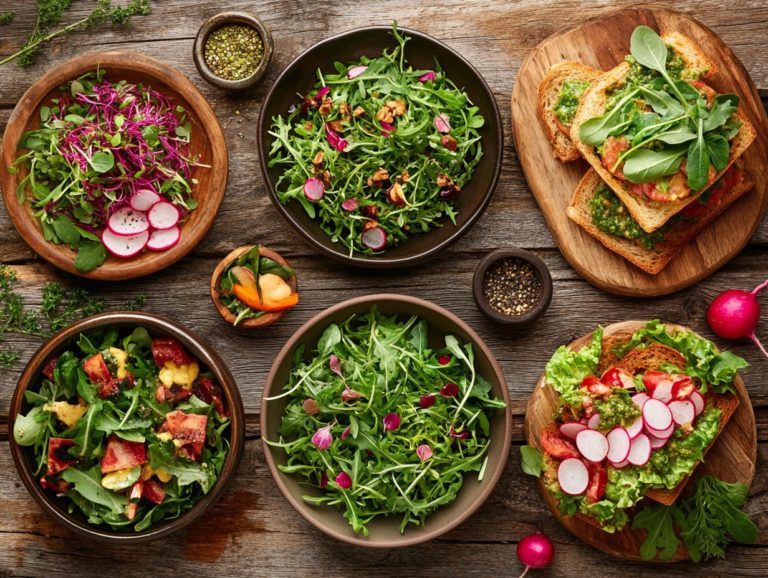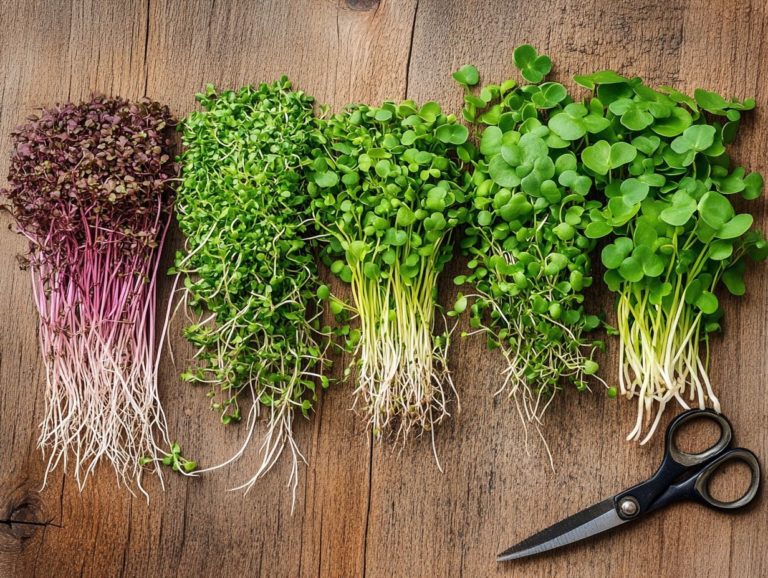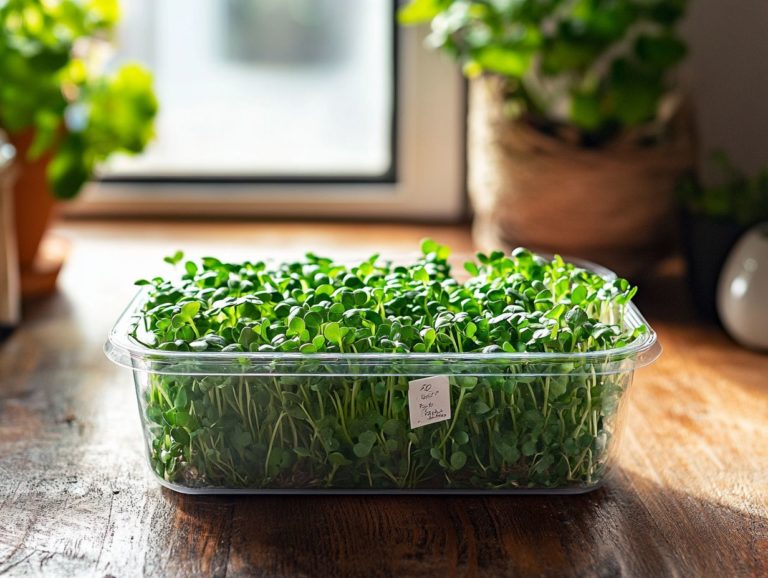Harvesting Microgreens: Timing and Techniques
Microgreens are tiny, flavorful powerhouses brimming with nutrients that can elevate any dish you prepare.
This article delves into the myriad benefits of growing microgreens and harvesting these miniature greens, showcasing their impressive nutritional value and culinary versatility. You will discover when to harvest microgreens for the best flavor and nutrition, along with effective harvesting techniques and tools that simplify the process.
It also provides tips on how to store and creatively incorporate fresh microgreens into your meals.
Dive in and discover how to enhance your culinary creations with these vibrant little gems. Explore exciting microgreen varieties that you can grow today!
Contents
- Key Takeaways:
- Benefits of Growing and Harvesting Microgreens
- Timing for Harvesting Microgreens
- Techniques for Harvesting Microgreens
- Storing and Using Harvested Microgreens
- Frequently Asked Questions
- When is the best time to harvest microgreens?
- How do I know when my microgreens are ready to be harvested?
- What is the best technique for harvesting microgreens?
- Can I harvest microgreens multiple times?
- Can I harvest different types of microgreens at the same time?
- What is the best time of day to harvest microgreens?
Key Takeaways:

- Microgreens are young, nutrient-dense plants harvested after their true leaves develop. They showcase quick growth and a high germination rate.
- Timing is crucial when harvesting microgreens for optimal nutrition and flavor, typically 7-14 days post-germination.
- Using clean scissors and cutting at soil level can prolong the freshness of microgreens.
What are Microgreens?
Microgreens are the young, edible seedlings of various vegetables and herbs that you can harvest shortly after their true leaves start to sprout, usually within 7 to 21 days after germination. You’ll find a delightful array of options, including popular choices like Red Cabbage, Purple Basil, and Cilantro.
These delicate greens are loved for their bold flavors, vibrant colors, and impressive nutritional density, making them a favorite among both culinary enthusiasts and health-conscious individuals.
Their appeal doesn’t stop there; microgreens flourish in small spaces, making them perfect for urban gardens or home setups. To grow these mini powerhouses, you’ll need minimal equipment—just seed trays, potting soil, and a source of adequate light, whether it’s natural sunlight or grow lights. For those interested in enhancing their growth techniques, understanding microgreen growth cycles can be beneficial.
With varieties like Pea Shoots, Sunflower, and Beet Greens at your fingertips, the versatility of microgreens allows you to create personalized flavor profiles, adding a burst of freshness to an array of dishes. They not only enhance visual appeal but also pack a significant punch of vitamins and minerals. If you’re interested in cultivating these greens, check out this guide on how to grow your favorite microgreen varieties, encapsulating the essence of healthy eating in a compact form.
Benefits of Growing and Harvesting Microgreens
The advantages of cultivating and harvesting microgreens go far beyond their visual appeal. They provide significant health benefits, boast rich flavor profiles, and offer unparalleled convenience for culinary enthusiasts.
Incorporating microgreens into your home garden or community-supported agriculture (CSA) initiative is undoubtedly a worthwhile endeavor. For those just starting out, learning how to grow microgreens for beginners can be incredibly beneficial. Research from Penn State University underscores their remarkable nutritional density, making them an asset to any cooking options.
Nutritional Value and Culinary Uses
Microgreens present an impressive level of nutritional density, often boasting higher concentrations of vitamins, minerals, and antioxidants than their mature counterparts. This makes them a favored choice for culinary enthusiasts like you, who seek to elevate dishes with vibrant colors, concentrated flavors, and delicate textures imagine the zesty kick of arugula or the unique taste of Red Amaranth.
These petite greens, ranging from basil to beet, aren’t merely visual garnishes; they serve as powerful flavor amplifiers and nutrient boosters. Consider mustard greens, which infuse salads with a spicy kick, or sunflower shoots, celebrated for their nutty flavor and crunchy texture ideal for enhancing the depth of your sandwiches.
Rich in folate and vitamins A, C, and E, microgreens provide significant health benefits that support immune function and skin health. By incorporating microgreens into your dishes, you not only elevate the overall taste profile but also deliver a substantial nutrient punch, making them a savvy choice for the health-conscious cook.
Timing for Harvesting Microgreens

Understanding the best time for harvesting microgreens is essential for maximizing their flavor and health benefits. By harvesting at just the right stage when the true leaves have developed but before the plants become leggy you ensure the best flavor profile.
This approach resonates with both health-conscious individuals and culinary enthusiasts who appreciate the nuances of fresh ingredients.
When to Harvest for Optimal Nutrition and Flavor
To achieve optimal nutrition and flavor, you should harvest microgreens at just the right moment typically after the seedlings have developed their true leaves. Use specific harvesting techniques that minimize damage to the delicate greens, employing clean scissors for precision cutting.
Timing is everything when it comes to enhancing both the flavor and nutritional profile of your microgreens. If harvested too early, those vibrant flavors and essential vitamins may not be fully developed. Conversely, waiting too long can lead to a loss of crispness and freshness. To ensure optimal growth, consider using effective watering techniques for thriving microgreens.
To attain the best quality, keep a close watch on their growth. Aim for that sweet spot when the leaves are tender and packed with flavor. Efficient harvesting techniques are key; cut just above the soil line and work in small batches to limit their exposure to air, which can compromise their quality. Additionally, consider learning how to extend the growing season for microgreens to enjoy them longer.
After harvesting, proper storage is essential. To get the most out of your greens, consider learning how to maximize yields from microgreens. Place your greens in perforated containers or moisture-controlled bags and stash them in the fridge. This will extend their lifespan and preserve that vibrant taste and nutritional goodness. Enjoy the fruits of your urban farming efforts!
Techniques for Harvesting Microgreens
Mastering the art of harvesting microgreens is crucial for maintaining their delicate texture and enhancing their flavor. You have a range of techniques at your disposal, including the use of clean scissors and effective cutting methods. These methods minimize stress on the plants, resulting in a harvest of superior quality.
Embracing these techniques elevates your culinary creations and honors the integrity of these vibrant greens.
Tools and Methods for Efficient Harvesting
Using the right tools and methods for efficiently harvesting microgreens can significantly enhance the quality and longevity of your harvest. Techniques like employing cutting tools and storing your greens in airtight containers will help preserve their freshness while taking full advantage of their rapid growth cycle.
Investing in high-quality scissors or knife sets designed specifically for delicate plants will minimize damage during cutting, ensuring each microgreen retains its vibrant texture and flavor. For optimal results, it’s also important to know about timing your microgreens to harvest them at their peak. Consider incorporating humidity-controlled storage containers; they can greatly extend the shelf life of these tender greens.
After harvest, handle your microgreens gently and swiftly to prevent wilting and dehydration. By understanding the optimal storage conditions like temperature and light exposure, you can maintain their nutritional integrity and taste. For further guidance, refer to this step-by-step guide to sowing microgreens and enjoy these nutritious bites to the fullest!
Storing and Using Harvested Microgreens
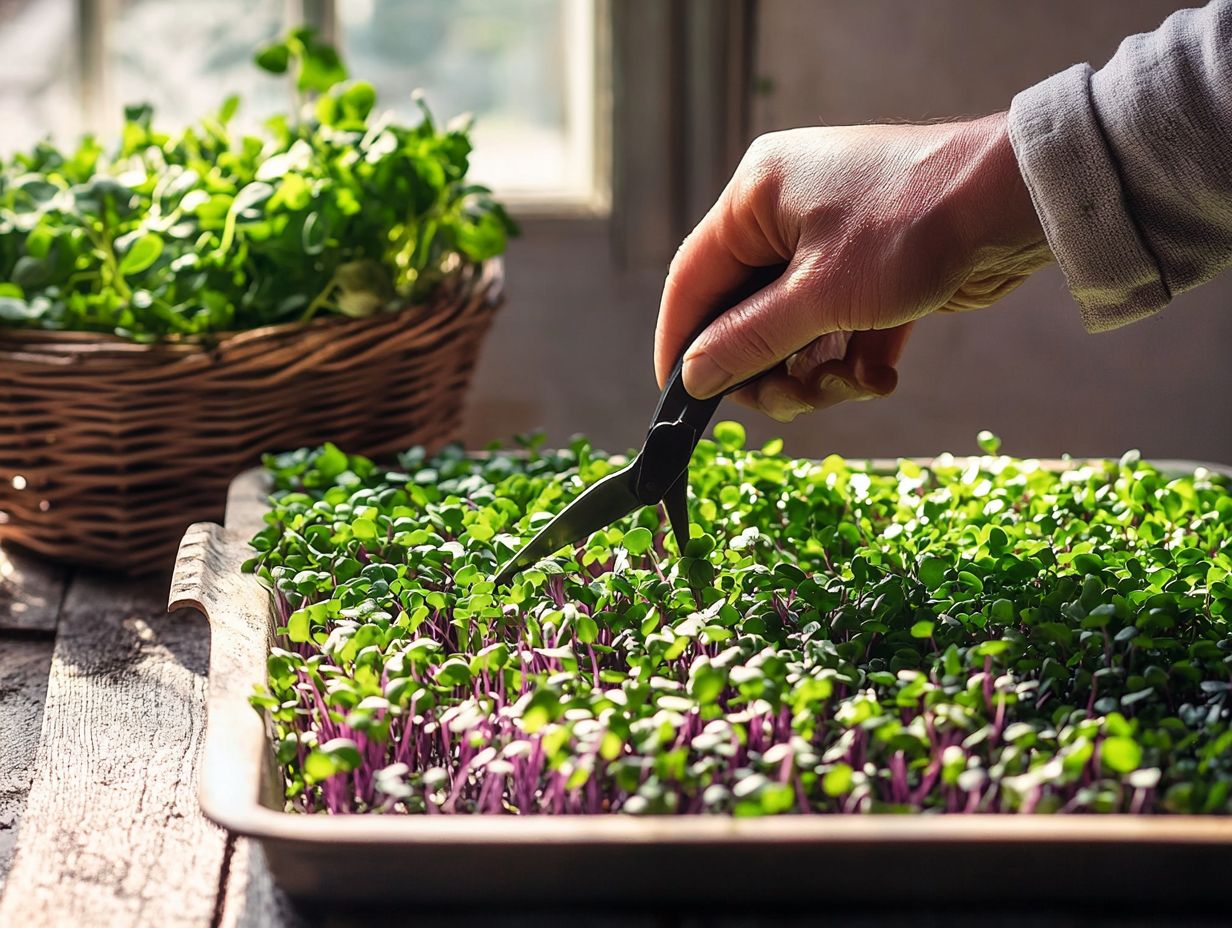
Storing your harvested microgreens properly is crucial for preserving their exquisite flavor profile and nutritional value.
To maintain their freshness, keep them in a cool environment and use air-tight containers. These storage tips are essential for culinary enthusiasts like you who are eager to craft innovative and delicious recipes.
Act fast to enjoy the full flavors of your microgreens!
Proper Storage and Creative Recipes
Proper storage techniques are essential for retaining the nutritional value and flavor of microgreens. This allows you to explore creative recipes like a microgreen salad, where these delicate greens truly shine alongside complementary ingredients.
To keep them fresh, store microgreens in a cool, dark place, ideally within a temperature range of 32 F to 40 F. Using breathable containers is key; they prevent moisture buildup, ensuring your vibrant greens remain crisp and bursting with flavor. For more tips, check out our techniques for growing microgreens year-round.
When stored correctly, microgreens can transform your dishes, making them vibrant and delicious! They enhance various meals, from adding flavor to dishes to elevating smoothies. For the best results, understanding microgreen harvest timing is essential. Fresh microgreens provide visual appeal and introduce unique textures and rich tastes, making them a coveted ingredient for any chef eager to innovate in the kitchen and satisfy consumer preferences.
Frequently Asked Questions
When is the best time to harvest microgreens?
Don t miss the perfect moment to harvest your microgreens when they reach a height of 1-3 inches and develop their first set of true leaves. This usually occurs 7-14 days after sowing, depending on the type of microgreen and its specific growing conditions.
How do I know when my microgreens are ready to be harvested?
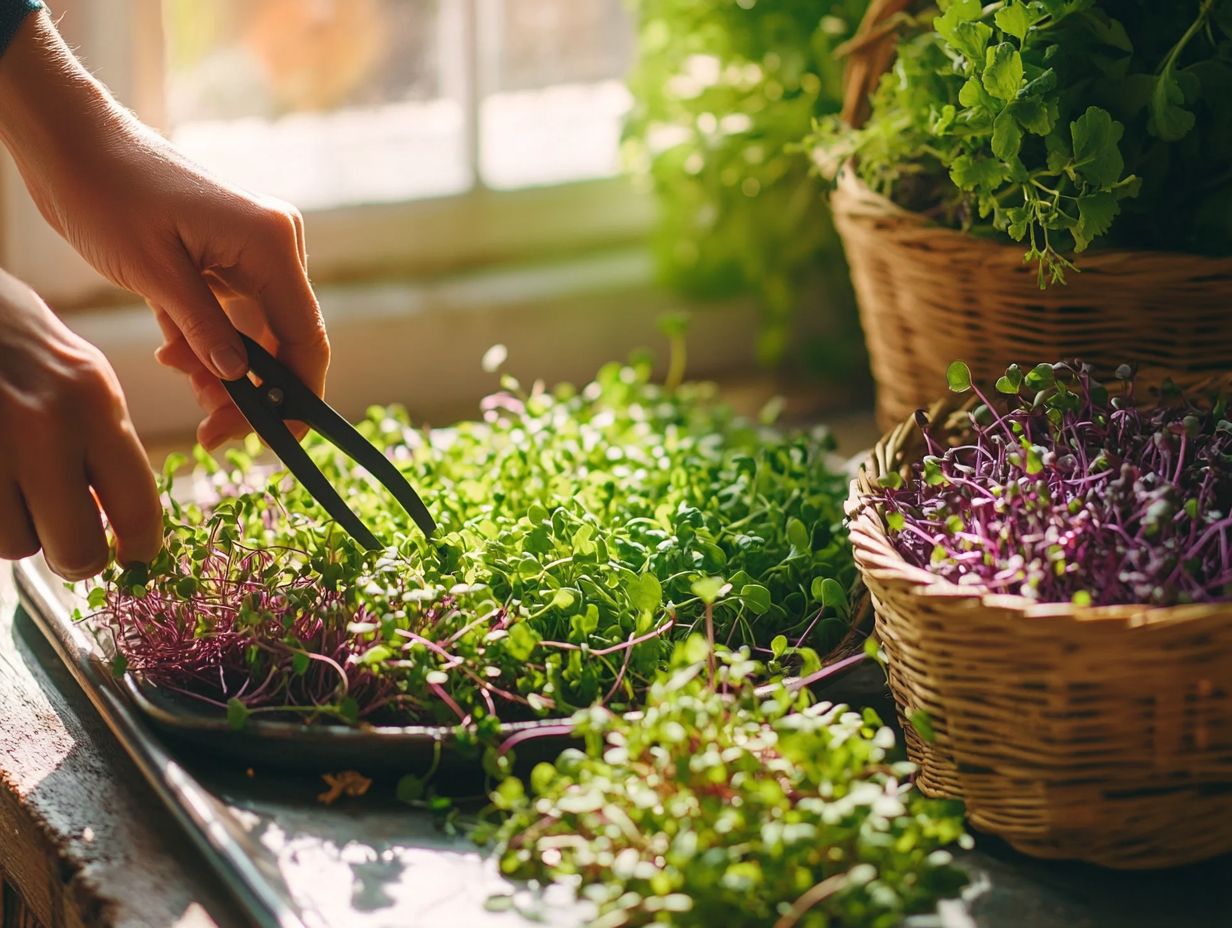
You will know your microgreens are ready to be harvested when they have reached their optimal size and developed vibrant color and flavor. The leaves should be fully open and not curled up, indicating good soil quality.
What is the best technique for harvesting microgreens?
The best technique for harvesting microgreens is to use a pair of sharp, clean scissors or a sharp knife. Gently cut the stems just above the soil line, being careful not to disturb the soil or roots.
Can I harvest microgreens multiple times?
It is possible to harvest microgreens multiple times, but the regrowth may not be as vigorous and flavorful as the first harvest due to potential plant stress. It is recommended to only harvest once to ensure the best quality and taste.
Can I harvest different types of microgreens at the same time?
Yes, you can harvest different types of microgreens at the same time, such as Red Cabbage, Purple Basil, and Red Amaranth, as long as they have reached their optimal size. Keep track of which types you are harvesting to prevent mixing them up.
What is the best time of day to harvest microgreens?
The best time of day to harvest microgreens is in the morning, after the plants have had a chance to absorb water and nutrients overnight. This is crucial for achieving the best taste and flavor during taste testing.
Get started today and enjoy fresh microgreens at home!

